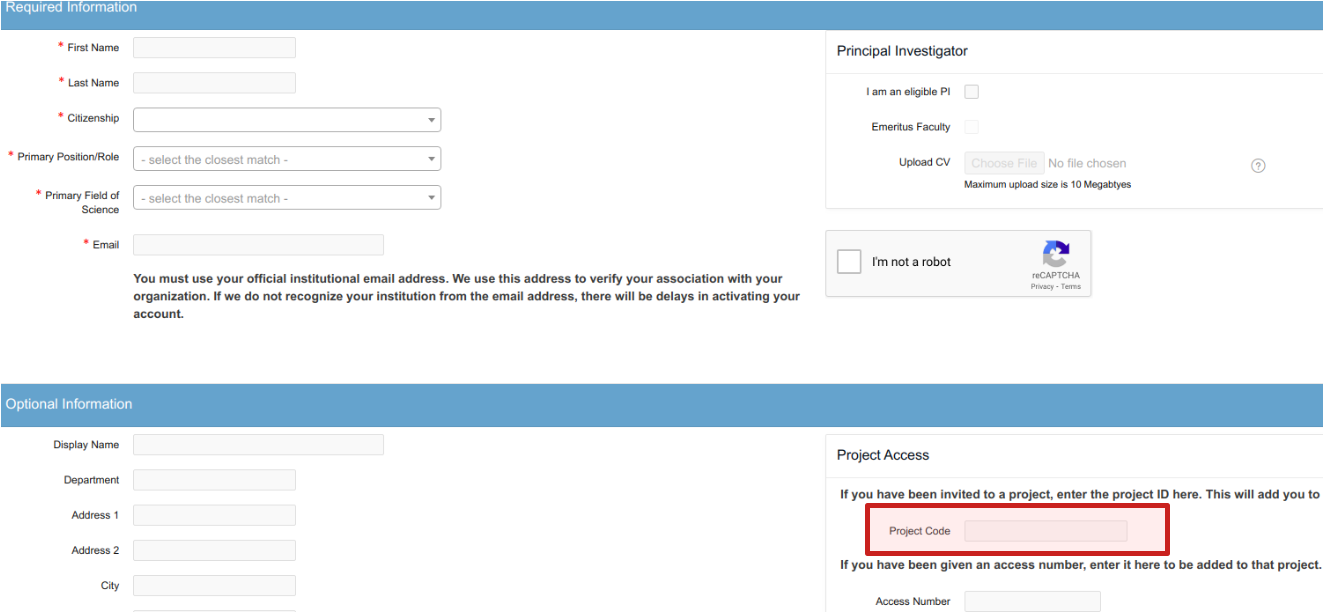Pre-workshop Setup
Required: Access to OSC
Make sure you have:
An account at the Ohio Supercomputer Center (OSC).
If you don’t, see the instructions below to get one.Access to an active OSC project.
If you don’t, contact the instructors to be added to a project.
Sign up at OSC
Go to https://my.osc.edu/ and click the blue “Sign Up” bar.
Fill out the form with your personal information (see screenshot below).
In the bottom right portion of the form, enter MCIC’s Project Code, which is
PAS0471.
 Enter Project Code
Enter Project Code PAS0471 in the red box.
Optional:
Local Software Installation
Since we’ll be working at OSC during this workshop, you don’t need to have any of the following locally installed for the workshop.
But you may be interested in having some essential computing software installed on your local computer for future work, if you don’t already:
Text editor
We recommend VS Code, which is available for all operating systems.
This is a great all-round editor with support for many programming languages, built-in terminals and consoles, Markdown previewing, git support, etc.
Conveniently, VS Code is also available as an Interactive App through OSC OnDemand.
Unix shell
Mac and Linux users have a Unix shell available by default.
To get a Unix shell in Windows, there are a couple of options.
- If you have Windows 10, consider installing Windows Subsystem for Linux (WSL).
- Otherwise, MobaXterm and git bash (which comes with Git for Windows) are two good options that include
ssh.
R and RStudio
Install R
- Windows: Download and run the
.exefile for the latest version of R from https://cran.r-project.org/bin/windows/base/, by clicking the largeDownload R [version-number] for Windowslink at the top of the gray box. - Mac: Download and run the
.pkgfile for the latest version of R from https://cran.r-project.org/bin/macosx/, by clicking the link just belowLatest release. - On a Linux distribution, you can also install R using the website above, but you may prefer to use a package manager instead – for instance, seee these instructions for installing the latest R version on Ubuntu 20.04 using the
aptpackage manager.
Install RStudio
RStudio is a so-called Integrated Development Environment (IDE) for R, with side-by-side panes for an R script, an R concole, plots, help documents, and much more. While it is perfectly possible to use R without RStudio, RStudio has become the de facto standard for working with R and is very useful.
To install RStudio, go to the RStudio download page and download and run the installer file for your operating system.
Update R
If your R version is below R 3.6, we strongly recommend updating it. You can check which version of R you have by looking at the first lines of output when running the following command inside R:
sessionInfo()To update:
Windows: You can update R from within R. The
updateR()function will also take care of updating your packages:install.packages("installr") installr::updateR()Mac: Download and install the latest
.pkgfile as if you were installing it for the first time.Linux: In Ubuntu, if you installed R with
aptorapt-get, you can useapt-get upgradein a terminal. Otherwise, download and install the latest version after removing the old one. Rtask has some instructions for upgrading to R 4.0 in Ubuntu (along with upgrading to Ubuntu 20.04).